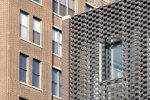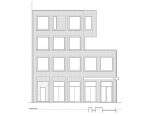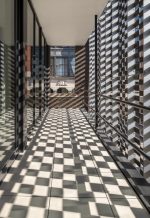Chicago’s Printers Row, located in the South Loop neighborhood, is home to a large collection of former warehouses and factory lofts built at the turn of the century. Built of steel-frame construction and wrapped in richly detailed brick, terra-cotta, and stone, the area is one of many zealously protected historic districts in the city. The challenge for any contemporary project within such a setting is to establish a unique and identifiable identity while fitting into the larger context. The Dearborn Residence, a single-family project designed by local architectural firm Filoramo Taslma Architecture, does just that, with playful massing clad in dark-gray brick and a hanging terra-cotta brise-soleil.
The 3,500-square-foot site is positioned within downtown’s high-density zoning area, and, technically speaking, does not have a particular height limit. That being said, the confines of the narrow corner location dictated that maximizing scale was not economically viable. “The massing of the building is first derived from the planning and program; where we wanted the spaces we needed,” said Filoramo Talsma co-founder Chris Talsma. “This resulted in the largest residential floor being on the top and the outdoor living space we desired being nearest the main living spaces on the second floor.”
In keeping with the historic district, the prevailing facade material is dark-gray brick arranged in a stretcher-bond format and sequenced as a colonnade at the retail podium. The rhythm of the colonnade rises to the second story, where openings screen and frame an outdoor terrace. Residential areas are largely illuminated by floor-to-ceiling glazing located on the south elevation. As a measure of privacy, and to mitigate glare from the curtain wall, the south elevation to shaded with a hanging terra-cotta screen produced by Shildan. The screen hangs from the top slab, and is made of 4-inch-tall and 6-inch-wide tiles.








